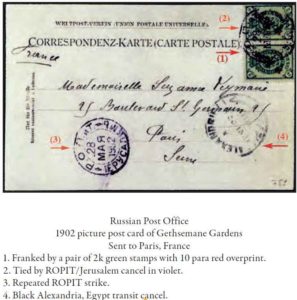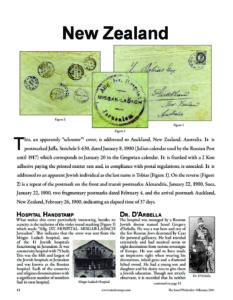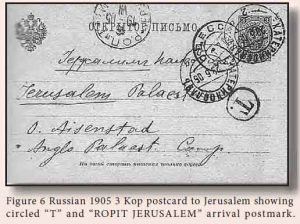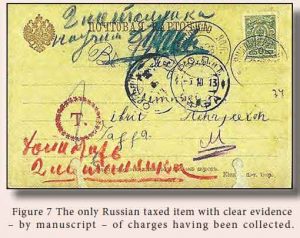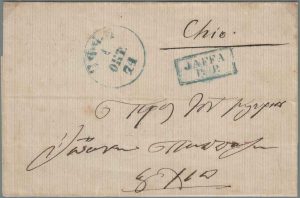FORERUNNERS
Russian Post Offices
In the early 19th century, the Russians established shipping Postcard sent on Christmas 1899 from Bethlehem via private courier to Jerusalem, then by the Austrian Post to Germany routes in the Eastern Mediterranean and provided a mail service. Russian postal service in the Ottoman Empire began in 1856 operated by the Russian Company of Trade and Navigation (Russkoe Obschchestvo Parokhodstva i Torgovli or ROPiT ). ROPiT handled mail service between the various offices, and forwarded mail to Russia through Odessa and their offices received a status equivalent to regular Russian post offices in 1863. ROPiT shipping and postal agencies existed in Akko (1868–1873), Haifa (1859–1860, 1906–1914), Jaffa (1857–1914) and Jerusalem (1901–1914).
Postal Cards & Envelopes, Turkish Period Mail From the Holy Land, The Israel Philatelist, February, 2011, p. 40.
Rare Russian Forerunner, New Zealand, The Israel Philatelist, February 2011, p. 12.
Figure 6. Another 3 Kop postcard is shown in Figure 6. It was mailed on June 29, 1905 from Ekaterinoslav to Jerusalem by the Zionist leader M. Usishkin, just before he left for the 7th Zionist Congress in Basel, Switzerland. This postcard is also underpaid 1 Kop, therefore an encircled “T” was applied, probably by the office of origin. Further markings are an Odessa transit mark on July 1, and “ROPIT JERUSALEM” arrival dated July 19, 1905.
Taxed Mail of the Ottoman Period Part 2, The Israel Philatelist, June 2012, p. 95.
The Figure 7 postcard, mailed in September 1913, bears a 2 Kop stamp and shows clear signs of another stamp which is missing. It shows a violet “T”, encircled by small stars, a handstamp and two manuscript notations.
These manuscripts prove to be most interesting. One, in red on the lower edge, reads “To collect 2 Metaliks”. The other, in blue, reads “2 Metaliks received” followed by a signature. A Metalik was an Ottoman coin equal to 10 paras, so the tax was 20 paras, equal to \4 Kopecks (1 Kopeck = 5 paras). This tax suggests that the missing stamp was the reason for
taxation – the postcard rate was 4 Kop and the tax of 4 Kop is twice the missing 2 Kop
Unfortunately, from the four items recorded for the Russian Office, it is not possible to conclude that any of the handstamps used were applied in the Holy Land. In all likelihood they were applied at the outgoing office as is usually the case.
Taxed Mail of the Ottoman Period Part 2, The Israel Philatelist, June 2012, p. 95.
Description
Date
Markings
“JAFFA 1 OKT 74” postmark in greenish-blue (Steichele 624)
Place of Origin
Place of destination
Object Type
Reg.Number
http://alexandercollection.org/collectionitem.aspx#collection=116&item=1345079780&startitem=5
April 5, 2017

